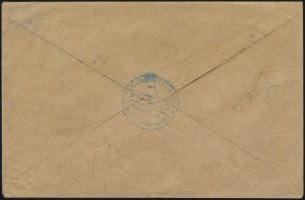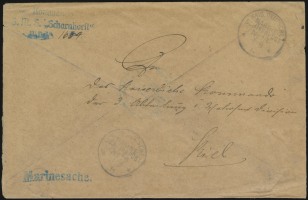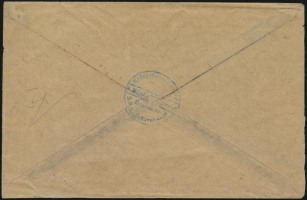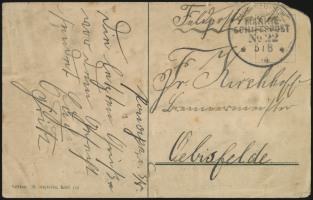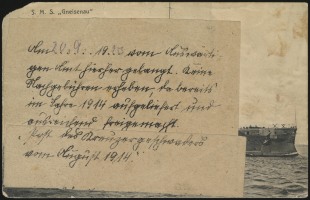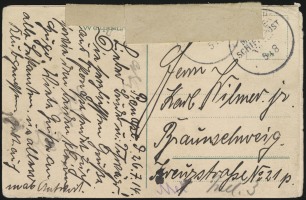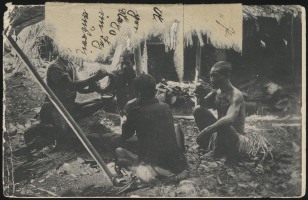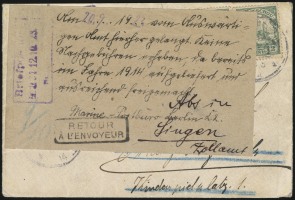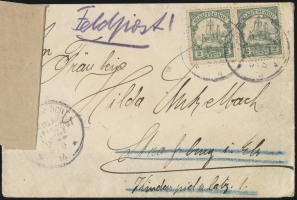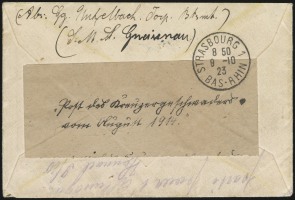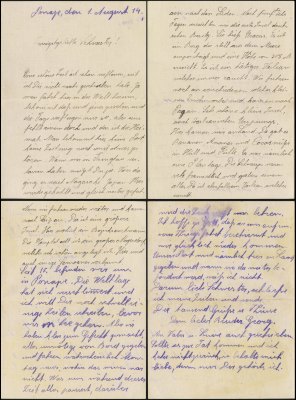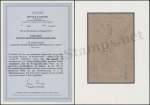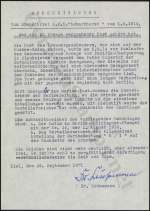Ponape Buried Mail
On 20 June 1914, the armored cruisers S.M.S. Scharnhorst (MSP 16) and S.M.S. Gneisenau (MSP 22) departed Tsingtau for a routine cruise to the German colonies in the South Pacific. They stopped at Nagasaki (22 June); Pagan, Marianen (28 June); Saipan, Marianen (29 June); Rota, Marianen (3 July); Olol, Karolinen (5 July); and Truk, Marianen (6 July). While at Truk, they were informed that war was imminent, and were ordered to proceed to Ponape, Karolinen, where they would be met by the light cruiser S.M.S. Nürnberg, then en route from the west coast of North America.
Upon the arrival of S.M.S. Nürnberg on 6 August 1914, the three cruisers departed for Pagan, Marianen, where they were to meet the light cruiser S.M.S. Emden. Prior to departing Ponape, however, the cruisers offloaded their accumulated mail with the local German postmaster, Herr Ludwig. This was a particularly important shipment of mail as the crewmembers knew by this point that they were going to war, and the mail contained the wills of many crewmembers as well as last wishes to family in Germany.
In the following months, Herr Ludwig was unable to send the mail back to Germany. The commercial steamship services had been disrupted by the outbreak of war, and no mail was coming or going from Ponape. In October 1914, in advance of the arrival of Japanese forces to occupy the island, Herr Ludwig handed the mail over to local Capuchin monks who buried it beneath the altar of the local Catholic church.
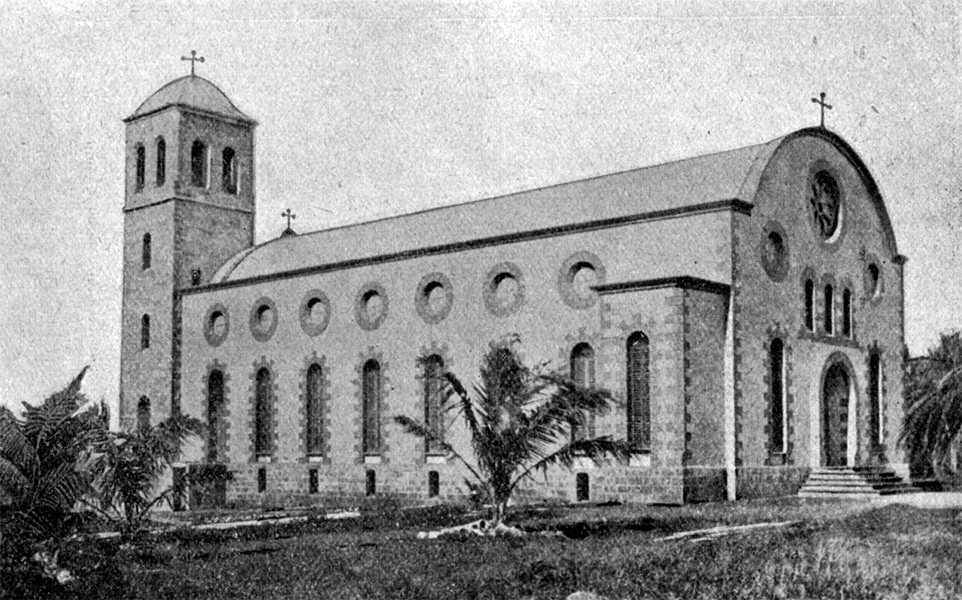
Catholic Church, Ponape
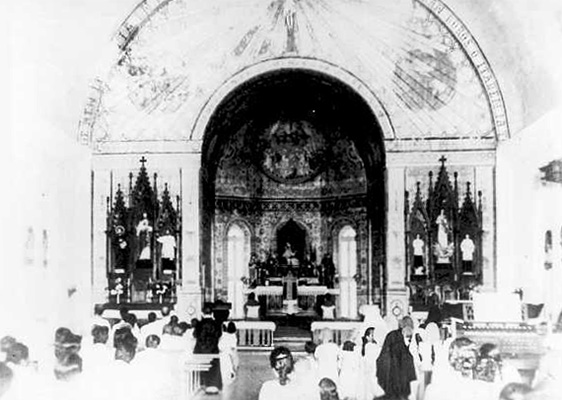
Altar of the Catholic Church, Ponape
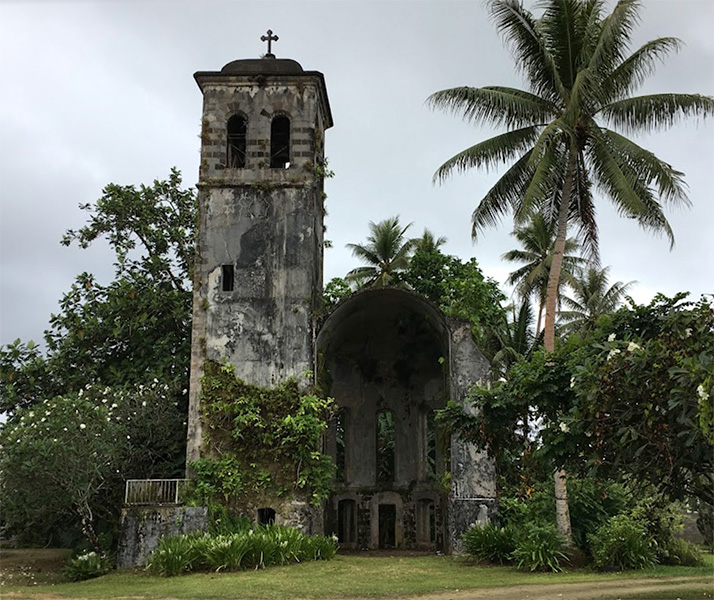
Remains of the Catholic Church, Ponape
Destroyed while used as storage depot by the Japanese in WWII
The last mail drop for S.M.S. Scharnhorst and S.M.S. Gneisenau prior to arriving in Ponape was 22 June 1914, the date they arrived in Nagasaki, thus setting the earliest possible cancellation date for mail from those vesssels as 22 June 1914. S.M.S. Nürnberg‘s last mail drop was on 27 July 1914 in Honolulu as it made its way west to Ponape.
The latest cancellation dates are 6 August 1914, the date the mail was delivered to Herr Ludwig.
Items from early in the eligible time period are franked in amounts that were standard for MSP of the time. Items dated 5-6 August 1914 were unfranked as Feldpost mail.
Items with Marianen or Karolinen postage are possible, as S.M.S. Scharnhorst and S.M.S. Gneisenau stopped in those locations prior to arriving at Ponape.
Items were also mailed by personnel on board the supporting vessels accompanying the cruisers (steamer Titania and Japanese collier Fukoku Maru), but as these vessels had no on-board postal facilities, items from those crewmwmbers can only be identified by the contents of the writings.
Following their departure from Ponape, S.M.S. Scharnhorst, S.M.S. Gneisenau, and S.M.S. Nürnberg rendezvoused with several other ships of the German navy and went to war. They won a victory over the Royal Navy at the Battle of Coronel on 1 November 1914, before all three were sunk at the Battle of the Falkland Islands on 8 December 1914.
In 1923, Japan permitted Germany to recover the mail that had been buried at Ponape. Environmental conditions had caused damage to most, but the Marine-Postbureau attempted delivery of the surviving items. These items included personal correspondence from individual sailors and official naval correspondence.
Official naval corresepondence received no additional markings other than “A I” written in pencil on the reverse.
These two official covers are from S.M.S. Scharnhorst to naval command in Kiel.
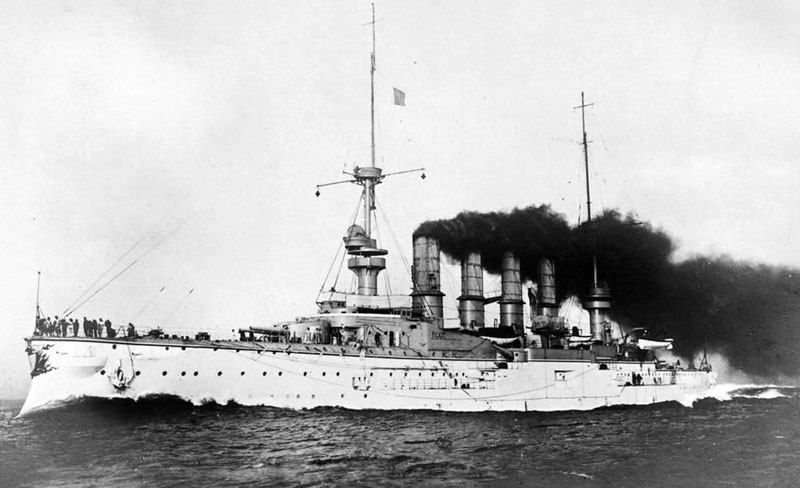
S.M.S. Scharnhorst
For private correspondence, two labels were attached explaining the circumstances of the delay in delivery. One translates as:
Arrived here from the Office of Foreign Affairs on 20 September 1923. No postage due is to be collected since this was legitimately mailed in the year 1914 and was sufficiently franked. Naval Post Office Berlin C-2, Berlin N65, Seestr. 37.
The other as:
Mail from the Cruiser Squadron of August 1914
These items are among the rarest items in German colonial philately.
The card shown below was sent by Friedrich “Fritz” Kirchhoff, a Torpedo Machinists Mate assigned to the 1st Company of the II. Torpedo Division on board the S.M.S. Gneisenau, to his father, also named Friedrich, in Oebisfelde, Germany.
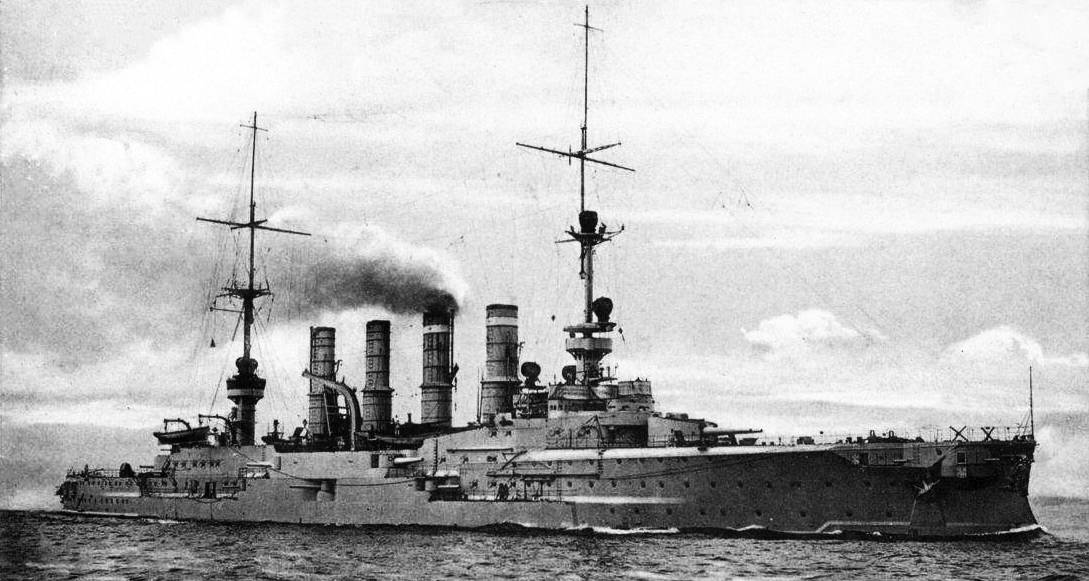
S.M.S. Gneisenau
The text translates as:
Ponape, August 5
Sending you final greetings before the battle.
Fritz
When the S.M.S. Gneisenau sank during the Battle of the Falkland Islands, 187 of her approximately 600-man crew were rescued by the British. Fritz Kirchhoff was not among them. Along with the remaining unaccounted-for crewmembers, he was officially listed as missing in action in the Germany Navy’s Casualty List Nr. 28a, dated 20 April 1915.

Excerpt from Casualty List
This card was sent by Hugo Wilmer, a sailor of the 1st Department, II. Sailors Division, S.M.S. Gneisenau, to his brother and sister in Braunschweig.
The card reads as follows:
Ponape, 26 July 1914
Dear Brother & Sister! Sending warmest greetings from Ponape to you and the two little Hugos. Many greetings to all our friends and all the club members.
Following the sinking of S.M.S. Gneisenau, Wilmer was rescued and taken prisoner by the British. He was officially listed as a POW in the Germany Navy’s Casualty List Nr. 28a, dated 20 April 1915.

Excerpt from Casualty List
This letter was sent by Georg Unkelbach, a Torpedo Boatswain’s Mate of the 2nd Company, II. Division, S.M.S. Gneisenau, to his sister in Straßburg. The first portion of the letter was written while in Saipan (June 1914), at which time the Kiautschou postage was presumably attached to cover the 4-cent letter rate to Germany. The remainder of the letter was written on 1 August 1914, after the ship’s arrival in Ponape. The letter was postmarked on 5 August 1914, at which time it could be sent as free Feldpost, obviating the need for the previously-attached postage.
The letter reads as follows:
Dearly beloved sister,
Some time has passed since I last wrote to you. Yes, I travel around the world, seeing this and that and the days just fly by, but there is one thing I’m missing and that is home. I don’t get any mail, newspapers, or anything else to read here. When we were in Tsingtau we usually had leave. From there we went to Nagasaki, Japan. Here we were paid, then left for the South. After five to six days we reached the first island under German ownership. Her name was Uracus. It is a mountain that rises steeply from the sea and reaches a height of 308 m. It is an active volcano that is always smoking. We traveled past various small islands like this and came to Pagan. Very beautiful little island, also of volcanic origin. This is where I came ashore. There were bananas, pineapples and coconuts in abundance. It was a plantation. The black people were very friendly and gave us everything. There is also a volcano that smokes. We continued on again and came to Saipan. This is a bigger island. A district magistrate lives here. The capital is a large Negro village that is beautifully laid out. Some Samoans are also exiled here.
We have been in Ponape since the 17th. The world situation has gotten worse and I want to write this quickly before we go to sea. So we made the ship ready to fight. Everything unnecessary has been taken off board and we’ll probably leave on Monday, to where we can’t say. What will happen to us during this time, we cannot say. I hope in time that we will be protected on our war journey and that we will return happily. Our mail is left here on land and I don’t know when it will be sent to the authorities there. Dear sister, I close my time and send you a thousand greetings and kisses.
Your dear brother Georg.
I have also written to Father and Luise. Should it happen and I don’t return, keep me dear, because I belong only to you.
Following the sinking of S.M.S. Gneisenau, Georg was rescued and taken prisoner by the British. He was officially listed as a POW in the Germany Navy’s Casualty List Nr. 28a, dated 20 April 1915.

Excerpt from Casualty List
By the time delivery of this letter was attempted in 1923, Straßburg was no longer German, having been ceded to France under the Treaty of Versailles at the conclusion of WWI. The French post office in Strasbourg received the letter, but marked it for return to sender. At some point, a note was added indicating that the sender could now be located at the Zollamt (customs office) in Lingen, Germany.
Ponape Buried Mail
On 20 June 1914, the armored cruisers S.M.S. Scharnhorst (MSP 16) and S.M.S. Gneisenau (MSP 22) departed Tsingtau for a routine cruise to the German colonies in the South Pacific. They stopped at Nagasaki (22 June); Pagan, Marianen (28 June); Saipan, Marianen (29 June); Rota, Marianen (3 July); Olol, Karolinen (5 July); and Truk, Marianen (6 July). While at Truk, they were informed that war was imminent, and were ordered to proceed to Ponape, Karolinen, where they would be met by the light cruiser S.M.S. Nürnberg, then en route from the west coast of North America.
Upon the arrival of S.M.S. Nürnberg on 6 August 1914, the three cruisers departed for Pagan, Marianen, where they were to meet the light cruiser S.M.S. Emden. Prior to departing Ponape, however, the cruisers offloaded their accumulated mail with the local German postmaster, Herr Ludwig. This was a particularly important shipment of mail as the crewmembers knew by this point that they were going to war, and the mail contained the wills of many crewmembers as well as last wishes to family in Germany.
In the following months, Herr Ludwig was unable to send the mail back to Germany. The commercial steamship services had been disrupted by the outbreak of war, and no mail was coming or going from Ponape. In October 1914, in advance of the arrival of Japanese forces to occupy the island, Herr Ludwig handed the mail over to local Capuchin monks who buried it beneath the altar of the local Catholic church.

Catholic Church, Ponape

Altar of the Catholic Church, Ponape

Remains of the Catholic Church, Ponape
Destroyed while used as storage depot by the Japanese in WWII
The last mail drop for S.M.S. Scharnhorst and S.M.S. Gneisenau prior to arriving in Ponape was 22 June 1914, the date they arrived in Nagasaki, thus setting the earliest possible cancellation date for mail from those vesssels as 22 June 1914. S.M.S. Nürnberg‘s last mail drop was on 27 July 1914 in Honolulu as it made its way west to Ponape.
The latest cancellation dates are 6 August 1914, the date the mail was delivered to Herr Ludwig.
Items from early in the eligible time period are franked in amounts that were standard for MSP of the time. Items dated 5-6 August 1914 were unfranked as Feldpost mail.
Items with Marianen or Karolinen postage are possible, as S.M.S. Scharnhorst and S.M.S. Gneisenau stopped in those locations prior to arriving at Ponape.
Items were also mailed by personnel on board the supporting vessels accompanying the cruisers (steamer Titania and Japanese collier Fukoku Maru), but as these vessels had no on-board postal facilities, items from those crewmwmbers can only be identified by the contents of the writings.
Following their departure from Ponape, S.M.S. Scharnhorst, S.M.S. Gneisenau, and S.M.S. Nürnberg rendezvoused with several other ships of the German navy and went to war. They won a victory over the Royal Navy at the Battle of Coronel on 1 November 1914, before all three were sunk at the Battle of the Falkland Islands on 8 December 1914.
In 1923, Japan permitted Germany to recover the mail that had been buried at Ponape. Environmental conditions had caused damage to most, but the Marine-Postbureau attempted delivery of the surviving items. These items included personal correspondence from individual sailors and official naval correspondence.
Official naval corresepondence received no additional markings other than “A I” written in pencil on the reverse. These two official covers are from S.M.S. Scharnhorst to naval command in Kiel.

S.M.S. Scharnhorst
For private correspondence, two labels were attached explaining the circumstances of the delay in delivery. One translates as:
Arrived here from the Office of Foreign Affairs on 20 September 1923. No postage due is to be collected since this was legitimately mailed in the year 1914 and was sufficiently franked. Naval Post Office Berlin C-2, Berlin N65, Seestr. 37.
The other as:
Mail from the Cruiser Squadron of August 1914
These items are among the rarest items in German colonial philately.
The card shown below was sent by Friedrich “Fritz” Kirchhoff, a Torpedo Machinists Mate assigned to the 1st Company of the II. Torpedo Division on board the S.M.S. Gneisenau, to his father, also named Friedrich, in Oebisfelde, Germany.

S.M.S. Gneisenau
The text translates as:
Ponape, August 5
Sending you final greetings before the battle.
Fritz
When the S.M.S. Gneisenau sank during the Battle of the Falkland Islands, 187 of her approximately 600-man crew were rescued by the British. Fritz Kirchhoff was not among them. Along with the remaining unaccounted-for crewmembers, he was officially listed as missing in action in the Germany Navy’s Casualty List Nr. 28a, dated 20 April 1915.

Excerpt from Casualty List
This card was sent by Hugo Wilmer, a sailor of the 1st Department, II. Sailors Division, S.M.S. Gneisenau, to his brother and sister in Braunschweig.
The card reads as follows:
Ponape, 26 July 1914
Dear Brother & Sister! Sending warmest greetings from Ponape to you and the two little Hugos. Many greetings to all our friends and all the club members.
Following the sinking of S.M.S. Gneisenau, Wilmer was rescued and taken prisoner by the British. He was officially listed as a POW in the Germany Navy’s Casualty List Nr. 28a, dated 20 April 1915.

Excerpt from Casualty List
This letter was sent by Georg Unkelbach, a Torpedo Boatswain’s Mate of the 2nd Company, II. Division, S.M.S. Gneisenau, to his sister in Straßburg. The first portion of the letter was written while in Saipan (June 1914), at which time the Kiautschou postage was presumably attached to cover the 4-cent letter rate to Germany. The remainder of the letter was written on 1 August 1914, after the ship’s arrival in Ponape. The letter was postmarked on 5 August 1914, at which time it could be sent as free Feldpost, obviating the need for the previously-attached postage.
The letter reads as follows:
Dearly beloved sister,
Some time has passed since I last wrote to you. Yes, I travel around the world, seeing this and that and the days just fly by, but there is one thing I’m missing and that is home. I don’t get any mail, newspapers, or anything else to read here. When we were in Tsingtau we usually had leave. From there we went to Nagasaki, Japan. Here we were paid, then left for the South. After five to six days we reached the first island under German ownership. Her name was Uracus. It is a mountain that rises steeply from the sea and reaches a height of 308 m. It is an active volcano that is always smoking. We traveled past various small islands like this and came to Pagan. Very beautiful little island, also of volcanic origin. This is where I came ashore. There were bananas, pineapples and coconuts in abundance. It was a plantation. The black people were very friendly and gave us everything. There is also a volcano that smokes. We continued on again and came to Saipan. This is a bigger island. A district magistrate lives here. The capital is a large Negro village that is beautifully laid out. Some Samoans are also exiled here.
We have been in Ponape since the 17th. The world situation has gotten worse and I want to write this quickly before we go to sea. So we made the ship ready to fight. Everything unnecessary has been taken off board and we’ll probably leave on Monday, to where we can’t say. What will happen to us during this time, we cannot say. I hope in time that we will be protected on our war journey and that we will return happily. Our mail is left here on land and I don’t know when it will be sent to the authorities there. Dear sister, I close my time and send you a thousand greetings and kisses.
Your dear brother Georg.
I have also written to Father and Luise. Should it happen and I don’t return, keep me dear, because I belong only to you.
Following the sinking of S.M.S. Gneisenau, Georg was rescued and taken prisoner by the British. He was officially listed as a POW in the Germany Navy’s Casualty List Nr. 28a, dated 20 April 1915.

Excerpt from Casualty List
By the time delivery of this letter was attempted in 1923, Straßburg was no longer German, having been ceded to France under the Treaty of Versailles at the conclusion of WWI. The French post office in Strasbourg received the letter, but marked it for return to sender. At some point, a note was added indicating that the sender could now be located at the Zollamt (customs office) in Lingen, Germany.


